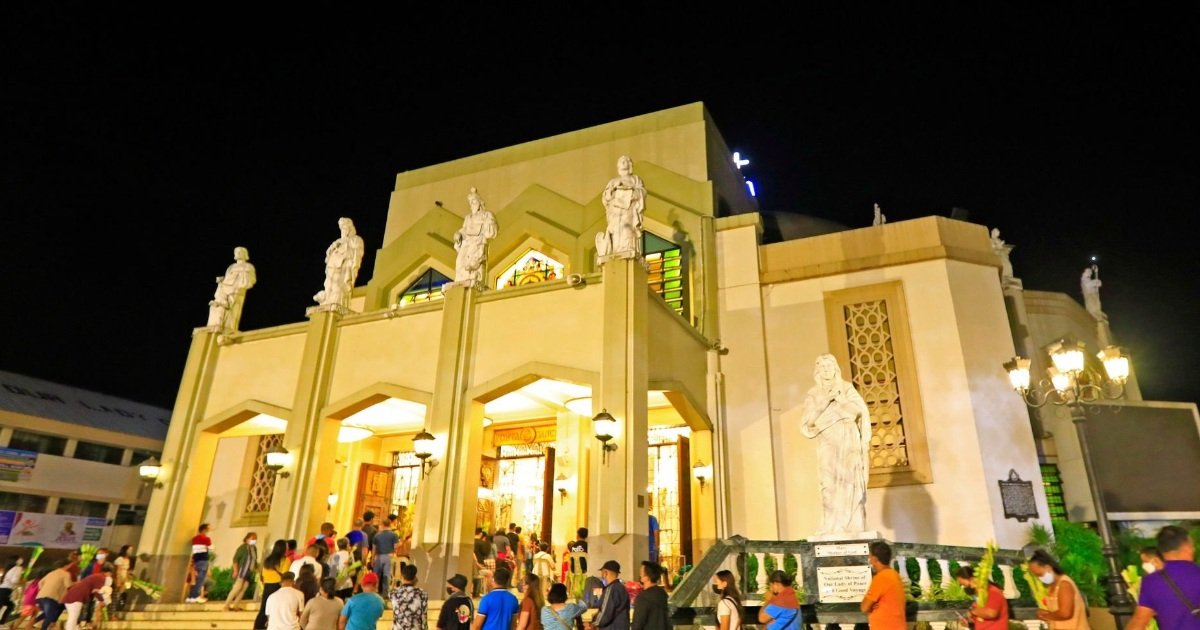Did you know that the Antipolo Cathedral in the Philippines attracts over one million visitors each year? This historic pilgrimage site, also known as the National Shrine of Our Lady of Peace and Good Voyage, holds great religious and cultural significance. Let’s explore the rich history, architectural marvels, and spiritual importance of this iconic cathedral.
Key Takeaways:
- Antipolo Cathedral is a renowned pilgrimage site attracting over a million visitors annually.
- It is also known as the National Shrine of Our Lady of Peace and Good Voyage.
- The cathedral holds deep religious and cultural significance in the Philippines.
- Explore the cathedral’s rich history, stunning architecture, and spiritual offerings.
- Join in pilgrimage and experience the transformative power of faith at Antipolo Cathedral.
The Storied History of Antipolo Cathedral
The history of Antipolo Cathedral is a testament to resilience and triumph, showcasing the unwavering faith of its devotees. From its establishment by the Franciscans to its reconstruction post-WWII, the cathedral has weathered numerous challenges, emerging stronger with each trial.
The Foundation by the Franciscans and the Jesuits
The roots of Antipolo Cathedral can be traced back to the time when it was founded by the Franciscans in the late 16th century. However, it was the Jesuits who took over the management of the cathedral in the 19th century. This transition in leadership marked a significant turning point in its history, ushering in a new era of growth and development.
Earthquakes and Reconstructions: A Testament to Resiliency
Throughout the centuries, Antipolo Cathedral has endured several destructive earthquakes that tested its fortitude. Each time, the cathedral rose from the ruins, undergoing reconstruction to restore its former glory. These reconstructions stand as a testament to the resilience and determination of the faithful, who refused to let the setbacks dampen their spirits.
From Destruction to Triumph: The Rebirth Post-WWII
The post-World War II era brought about a new chapter in the history of Antipolo Cathedral. Devastated by the war, the cathedral underwent an extensive reconstruction effort, symbolizing the resilience of the Filipino people. The reconstruction not only restored the physical structure of the cathedral but also breathed new life into its spiritual significance. It was during this time that Antipolo Cathedral was elevated to the status of a national shrine, solidifying its place as a beacon of hope and devotion in the Philippines.
| Year | Event |
|---|---|
| Late 16th century | Establishment of Antipolo Cathedral by the Franciscans |
| 19th century | Leadership transition to the Jesuits |
| Various dates | Destructive earthquakes, leading to multiple reconstructions |
| Post-WWII | Extensive reconstruction and elevation to national shrine status |
The Antipolo Cathedral: A National Shrine to Our Lady of Peace and Good Voyage
Antipolo Cathedral, also known as the National Shrine of Our Lady of Peace and Good Voyage, holds a significant place of worship in Antipolo City, Philippines. The cathedral is a sanctuary for devoted pilgrims who seek solace and spiritual guidance from Our Lady of Peace and Good Voyage, the patron saint of Antipolo.!
At the heart of the cathedral lies a revered 17th-century image of the brown-skinned Madonna, known as “Nuestra Señora de la Paz y Buen Viaje.” Our Lady of Peace and Good Voyage stands as a beacon of hope and protection for those embarking on journeys, both physical and spiritual.
The designation of Antipolo Cathedral as a national shrine reinforces its cultural and religious significance. It serves as a sacred space where devotees pay homage to their patron saint, finding comfort and strength in her intercession. The cathedral’s grandeur and rich history captivate visitors as they connect with the deep-rooted faith and traditions of the local community.
Architectural Marvel and Artistry of the Cathedral in Antipolo
Antipolo Cathedral is not just a place of worship; it is also an architectural marvel that showcases the artistry of Filipino craftsmen. Designed by renowned architect José L. De Ocampo, the cathedral stands as a testament to his vision and expertise in creating stunning structures.
Architect José L. De Ocampo’s Vision Realized
José L. De Ocampo, a highly acclaimed architect in the Philippines, brought his creative vision to life through the design of Antipolo Cathedral. His expertise in blending traditional and contemporary elements is evident in the cathedral’s intricate details and captivating architectural features. De Ocampo’s design not only creates a visually stunning structure, but it also enhances the spiritual experience of visitors.
Key Features: The Historical Marker and Art
Antipolo Cathedral is not only a testament to architectural brilliance, but it also holds historical significance. The cathedral proudly houses a historical marker that highlights its importance in Philippine history. This marker serves as a reminder of the cathedral’s role in shaping the cultural and religious landscape of Antipolo City.
In addition to the marker, the cathedral features various artworks that add to its cultural significance. These artworks, ranging from paintings to sculptures, represent the rich artistic heritage of the Philippines and contribute to the overall beauty of the cathedral.

Spiritual and Cultural Significance: Pilgrimage Site and Relic Keeper
Antipolo Cathedral holds immense spiritual and cultural significance for the faithful and the local community. As a pilgrimage site, it attracts thousands of devotees who come to seek solace, offer prayers, receive blessings, and participate in religious rituals. The cathedral’s historical and religious importance makes it a cherished destination for pilgrims from all walks of life.
The Antipolo Cathedral is not just a place of worship; it also serves as a relic keeper. Within its hallowed walls, the cathedral houses sacred artifacts and relics that hold deep religious and cultural meaning. These artifacts serve as tangible connections to the past, symbolizing the faith and devotion of generations who have come before.
“The Antipolo Cathedral is a sacred space where people find comfort, strength, and inspiration in their spiritual journeys. It is a place where the faithful can connect with the divine and encounter the transcendent through prayer, reflection, and participation in religious traditions.”
Visiting the cathedral offers pilgrims the opportunity to experience the power of faith firsthand and engage with the rich spiritual tapestry of the local community. The reverence shown towards the relics and the act of pilgrimage itself allow individuals to deepen their connection to their own faith, find peace, and seek guidance in their lives.
Whether it is the act of touching a relic, witnessing a religious procession, or immersing oneself in the sacred atmosphere, the Antipolo Cathedral brings together the spiritual and the cultural, creating a profound experience for those who embark on this pilgrimage.
| Pilgrim Experiences | Religious Rituals | Deep Connection |
|---|---|---|
| Encountering sacred relics | Participating in processions | Strengthening faith and spirituality |
| Seeking blessings and intercession | Attending Mass and prayers | Finding solace and peace |
| Reflecting on personal journeys | Offering votive candles and prayers | Connecting with the local community |
Antipolo Cathedral’s Role in Philippine Religious Tourism
Antipolo Cathedral, with its rich religious heritage and cultural significance, plays a vital role in promoting Philippine religious tourism. With its recent recognition as an international shrine, the cathedral has garnered global attention, attracting visitors from all corners of the world.
The international shrine status of Antipolo Cathedral signifies its importance as a pilgrimage site and a destination for spiritual seekers. Devotees and tourists alike are drawn to the cathedral’s serene ambiance, stunning architecture, and the opportunity to experience the spiritual traditions and practices of the local community.
In addition to being a pilgrimage site, Antipolo Cathedral hosts a variety of religious events that contribute to the promotion of local tourism in Antipolo. These events include religious processions, feast day celebrations, and regular devotions, which provide a unique cultural experience to visitors.

The cathedral serves as a cultural and spiritual hub, offering visitors a chance to immerse themselves in the rich history and traditions of Antipolo. Through their participation in religious events and engagement with the local community, tourists can gain a deeper understanding of the region’s religious heritage and forge meaningful connections with the people of Antipolo.
Antipolo Cathedral’s role in Philippine religious tourism extends beyond its status as an international shrine. It symbolizes the country’s rich religious and cultural heritage while providing a platform for tourists to explore and engage with the spiritual traditions that shape the lives of the Filipino people.
| Key Highlights of Antipolo Cathedral’s Role in Philippine Religious Tourism |
|---|
| Recognition as an international shrine |
| Attraction of visitors from around the world |
| Hosting religious events and processions |
| Contribution to the promotion of local tourism in Antipolo |
| Emphasis on cultural and spiritual immersion |
The Impact of Our Lady of Peace and Good Voyage on Pilgrims
The devotion to Our Lady of Peace and Good Voyage at Antipolo Cathedral has a profound impact on pilgrims. Many devotees attribute their journeys’ success, protection, and peace to the intercession of Our Lady. The cathedral serves as a place of solace, renewal, and inspiration for pilgrims, fostering a deep connection with their faith and the patroness of Antipolo.
Pilgrims from all walks of life come to Antipolo Cathedral seeking guidance, blessings, and spiritual fulfillment. They embark on their journeys with unwavering devotion to Our Lady of Peace and Good Voyage, believing in her power to navigate the tumultuous seas of life and guide them to safety and prosperity.
“Our Lady of Peace and Good Voyage has been my constant companion throughout my travels. I believe that she has protected me from harm and guided me towards success,” said a devoted pilgrim.
In times of uncertainty and challenges, pilgrims find solace and strength in their deep connection with Our Lady of Peace and Good Voyage. They offer prayers, light candles, and participate in religious rituals, pouring out their hearts and seeking intercession for their hopes, dreams, and concerns.
The devotion to Our Lady of Peace and Good Voyage transcends geographical boundaries. Pilgrims from different parts of the Philippines and even from around the world gather at Antipolo Cathedral to express their gratitude and seek blessings from the patroness.
Through the intercession of Our Lady of Peace and Good Voyage, pilgrims form a spiritual bond with the cathedral and each other. They find comfort in their shared experiences and stories, creating a sense of unity and belonging in their pilgrimages.
| Benefits of Devotion to Our Lady of Peace and Good Voyage | Impact on Pilgrims |
|---|---|
| Protection from harm | Pilgrims attribute their safety during travels to the intercession of Our Lady of Peace and Good Voyage. |
| Guidance and direction | Devotees believe that Our Lady of Peace and Good Voyage guides them through life’s challenges and helps them make important decisions. |
| Peace and serenity | Pilgrims experience a sense of calm and inner peace when they connect with Our Lady of Peace and Good Voyage. |
| Success and prosperity | Many devotees credit their achievements and blessings in life to the intercession of Our Lady of Peace and Good Voyage. |
Antipolo Cathedral’s Engagement with the Community
Antipolo Cathedral goes beyond being a place of worship; it actively engages with the local community, fostering faith, and strengthening bonds through various initiatives and programs. The cathedral serves as a spiritual center that brings people together, providing a platform for worship, spiritual growth, and community connection.
Fostering Faith Through Religious Services
The religious services at Antipolo Cathedral play a vital role in fostering faith and providing a meaningful worship experience for the community. Whether it’s attending the regular Mass or participating in special religious celebrations, individuals have the opportunity to deepen their spiritual connection and find solace in the cathedral’s sacred atmosphere.
Through the guidance of clergy and the support of fellow worshipers, Antipolo Cathedral creates an environment that nourishes spiritual growth and encourages individuals to live out their faith in daily life. The power of communal prayer and reflection helps strengthen the overall faith community and build a sense of shared purpose.
Extension of Outreach and Prayer Support
Antipolo Cathedral is committed to extending its outreach beyond its physical walls. With various programs and initiatives, the cathedral provides prayer support and guidance to those in need. Whether it’s offering counseling services, organizing spiritual retreats, or facilitating outreach programs, the cathedral aims to uplift and inspire individuals in their spiritual journeys.
Prayer is a cornerstone of Antipolo Cathedral’s engagement with the community. The cathedral welcomes prayer requests from individuals facing challenges, difficulties, or seeking guidance. Through the power of collective prayer, the community comes together to support one another and offer comfort and hope in times of need.
Furthermore, the cathedral actively supports charitable works and social initiatives. By partnering with local organizations and communities, Antipolo Cathedral strives to make a positive impact and be a source of light and compassion in the wider Antipolo community.

| Antipolo Cathedral’s Community Engagement | Benefits |
|---|---|
| Religious Services |
|
| Extension of Outreach |
|
| Prayer Support |
|
| Charitable Works |
|
Through its engagement with the community, Antipolo Cathedral aims to create an inclusive and supportive environment that fosters faith, compassion, and a sense of belonging. The cathedral’s dedication to serving the spiritual and practical needs of its community demonstrates its commitment to being a source of strength and inspiration for all.
The Commemorative Events at Antipolo Cathedral
Antipolo Cathedral offers a host of commemorative events throughout the year to honor its patroness and celebrate important religious milestones. These events provide a sacred opportunity for the faithful to come together, express their deep devotion, and strengthen their faith in a collective setting.
One of the most anticipated events at Antipolo Cathedral is the Feast Day celebration. On this special occasion, devotees gather to honor Our Lady of Peace and Good Voyage, the cathedral’s patroness. The Feast Day is marked by vibrant processions, solemn Masses, and heartfelt prayers in gratitude for the intercession and blessings received. It is a joyous occasion that unites the community in their shared faith and devotion.
In addition to the Feast Day, Antipolo Cathedral hosts regular devotions that allow the faithful to deepen their spiritual connection. These devotions include novenas, rosary prayers, and special liturgical services focused on specific intentions or themes. Regular devotions provide a consistent space for worship, contemplation, and reflection, enabling individuals to strengthen their relationship with God and deepen their faith.
Furthermore, the cathedral organizes processions and pilgrimages to important religious sites. These sacred journeys provide a meaningful experience for pilgrims, offering them an opportunity to embark on a physical and spiritual journey of faith. Participating in processions and pilgrimages allows the faithful to demonstrate their devotion, offer prayers, and seek spiritual renewal in the presence of their patroness.
Antipolo Cathedral’s commemorative events encapsulate the rich traditions, deep spirituality, and unwavering faith of the community. They serve as powerful reminders of the cathedral’s enduring significance and its role in fostering a strong sense of community among the faithful.
Antipolo Cathedral: A Beacon of Hope and Peace in Rizal Province
Antipolo Cathedral stands as a symbol of hope, resilience, and faith in the midst of adversity. As the cathedral has weathered earthquakes, wars, and other challenges throughout its history, it has emerged as a testament to the enduring spirit of the Filipino people. The cathedral’s majestic presence serves as a beacon of hope for the community, offering solace and comfort to those in need.

Surviving Adversity: A Symbol of Filipino Faith
The Antipolo Cathedral’s ability to withstand adversity reflects the strength and resilience of the Filipino people. Despite the challenges it has faced, the cathedral has remained steadfast, imparting a sense of resilience and faith to both its worshippers and the surrounding community. Its enduring presence serves as a powerful reminder of the unwavering devotion and deep-rooted faith that characterize Filipino culture.
Serving as a Spiritual Center for the Community
Antipolo Cathedral plays a significant role in the lives of the local community, serving as a spiritual center and a source of inspiration. It provides a sanctuary for worship, prayer, and reflection, where individuals can find solace and guidance in their spiritual journeys. The cathedral fosters a sense of belonging and unity, bringing the community together in faith and offering support during challenging times.
Discovering the Antipolo Cathedral: Visita Iglesia and Personal Journeys
A visit to the Antipolo Cathedral offers a profound journey of discovery for visitors. One popular activity is the practice of Visita Iglesia, where individuals visit multiple churches for prayer, reflection, and deepening of spirituality. Within the walls of Antipolo Cathedral, visitors can explore the rich cultural heritage and contemplate their personal faith journeys.
Whether partaking in organized pilgrimages or embarking on personal quests, many find solace, inspiration, and a sense of connection within the serene atmosphere of Antipolo Cathedral. The stunning architecture, religious art, and the presence of the National Shrine of Our Lady of Peace and Good Voyage create an immersive experience for those seeking spiritual growth and cultural exploration.
As visitors engage in the practice of Visita Iglesia at Antipolo Cathedral, they have the opportunity to reflect on their personal faith and participate in ancient traditions. The journey within the cathedral’s sacred walls becomes a deeply personal and enriching experience, evoking a sense of awe and reverence.
By embarking on personal journeys to Antipolo Cathedral, visitors can connect with the centuries-old traditions of the Catholic faith and witness the enduring legacy of this historic pilgrimage site. Whether seeking solace, inspiration, or a renewed sense of purpose, the Antipolo Cathedral provides a sacred space for individuals to embark on their spiritual quests.
The Antipolo Cathedral Mass Schedule and Visitor Information
Ease of Access: Times, Location, and Contact
Antipolo Cathedral warmly welcomes visitors to join in its religious services and experience the spiritual atmosphere. To ensure accessibility, the cathedral provides a regular mass schedule that caters to the needs of worshipers.
The mass schedule at Antipolo Cathedral varies throughout the week, offering multiple opportunities for devout individuals to participate. Whether you prefer early morning masses or evening services, you can find a time that suits your schedule. The cathedral strives to accommodate the diverse needs of its visitors.
Located in Antipolo City, Rizal, Philippines, the cathedral is conveniently situated within reach of the local community and tourists alike. Its central location makes it easily accessible for those who wish to attend religious services or explore the splendid architectural marvel.
If you have any inquiries or require additional information, the contact details of Antipolo Cathedral are as follows:
Antipolo Cathedral
Location: M.L. Quezon Street corner P. Oliveros Street, Barangay San Roque, Antipolo City, Rizal, Philippines
Contact: +63 123 456 789
The Celebration of Feasts and Regular Devotions
Antipolo Cathedral is not only a place of worship but also a site of vibrant celebrations and devotions. Throughout the year, the cathedral observes various feasts and regularly holds devotional activities, providing visitors with a unique opportunity to engage with the spiritual and cultural offerings.
Feast days at Antipolo Cathedral are significant occasions that honor Our Lady of Peace and Good Voyage, the cathedral’s patron saint. These festive celebrations bring devotees together, fostering a sense of community, shared faith, and gratitude for divine blessings.
In addition to the grand feasts, the cathedral also hosts regular devotions that allow individuals to deepen their spirituality and connect with their beliefs on a more personal level. These devotional activities provide a serene and reflective atmosphere, attracting pilgrims seeking solace, inspiration, and guidance during their spiritual journeys.
Conclusion
Reflecting on the Enduring Legacy of Antipolo Cathedral
Antipolo Cathedral holds an enduring legacy that continues to inspire and captivate both locals and visitors. With its rich history, cultural significance, and spiritual offerings, the cathedral leaves a lasting impression on all who encounter it. From its foundation by the Franciscans and the Jesuits to its post-World War II reconstruction, the cathedral stands as a symbol of resilience and faith, showcasing the indomitable spirit of the Filipino people.
Joining Hands in Pilgrimage: A Call to Participation and Prayer
The cathedral invites individuals from all walks of life to join in pilgrimage, participate in its events, and engage in prayer. By doing so, they become part of a community bound by a shared devotion, fostering a deep sense of connection and unity. The cathedral’s serene atmosphere and transformative power of faith provide solace and inspiration, allowing visitors to embark on personal journeys of reflection, renewal, and spiritual growth.
As Antipolo Cathedral stands tall as a symbol of faith, it beckons all to experience its beauty, serenity, and the profound impact it has on the lives of its pilgrims. Whether seeking blessings, guidance, or a moment of quiet contemplation, the cathedral warmly embraces each visitor, inviting them to discover the enduring legacy that lies within its hallowed walls.
FAQ
What is the history of Antipolo Cathedral?
The Antipolo Cathedral was first established by the Franciscans and later taken over by the Jesuits. It has faced several earthquakes throughout its history, resulting in multiple reconstructions. Its post-World War II reconstruction marked a significant milestone.
Source Links
- http://antipolocathedral.com/our-story.html
- https://philstarlife.com/news-and-views/936837-antipolo-cathedral-international-shrine
- https://www.rappler.com/nation/antipolo-city-alay-lakad-tradition-holy-thursday/

